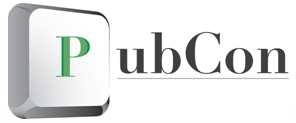
Heya! We’re back. And it’s time to talk about something that’s near and dear to my heart – helping small business owners grow traffic. This time the focus will be on using PR campaigns to accomplish it. Up on stage we have three awesome and incredibly smart folks: Guillaume Bouchard, Lisa Buyer, and Sean Jackson. Andy Beal notices me stretching in the audience and tells me I have to keep going because I can’t let Brett down. Geez, pressure much?
Up first is Guillaume. He starts talking in French. Because he’s funny. Or at least he *thinks* so. :)
Online PR accelerates the natural link attraction process. You attract links via brand awareness (people talking about your product) and new content. That’s how you get natural links flowing to your site. You can’t just keep pushing new content from your own page because that bores people. You need to build specific pages on blogs and articles that will do better in social media than your home page. You want to have content that lives on your site that will attract a lot of buzz and links.
Hi. He talks really fast. OMG my wrists. Are they still attached? I can’t tell.
Four Key PR Tactics
1. Event Management
Engaging bloggers, conferences, meetups, stunts, contests [more traditional type of PR]
- Used online and offline, preferably both
- Target bloggers
- offer incentives
- develop suitable content
- master platform before launch
- update content regularly during the event
- Don’t let it die after the event
SEO Strategy
- Blend incentives with link attraction
- develop linkworthy pages
- stay on domain
- link accordingly
2. Community Management
Participation in social communities, brand monitoring [He mentions Andy Beal’s tool Trackur. Partly because it’s a great tool and partly because Andy is the panel moderator ;) Just kidding. Trackur rocks.]
The Platforms
- Social sites: Facebook, Twitter, YouTube
- Content: Sites, blogs, mobile, web apps, contests, email
PR Strategy
- Target power users, consumers
- Proactive partnerships, building loyalty
- Engage with them transparency
- Have a clear objective
- Measures results
SEO Strategy: Comes from brand awareness. Won’t help you rank from a text-type result, but will help you in the other areas.
3. Social News Optimization
Promoting content on social media news site.
The Platforms
- Social Sites: StumbleUpon, Digg, Reddit, Mixx
- Content: Blog
The Strategy
- Develop the platform
- Develop high quality content
- Engage with power users, influencers
SEO Strategy
- Keyword use, if possible
- Interlink accordingly
4. Widgets
Developing small applications for bloggers to put on their sites
The Platforms
- Blogs
The Strategy
- Conceive a plausibly installable widget
- Identify a blog target vertical likely to install the widget
- Develop the widget
- Contact blogs
- Maintain widget content
SEO Strategy
- Widget contains links
- Can develop the widget in Flash, complete HTML shell behind
- In contacting, the brand gets promoted
He gives an example where one widget equaled a 65 percent traffic growth for ClubMed. 45 percent from Facebook, Club Med and blogs with the widget. 15 percent increase in direct traffic. Nice.
Next up is Lisa Buyer.
PR: Where to Next?
Things have changed drastically over the last five years with social media and the SEO influence. Experts agree that what matters most is content – and we’re not just talking about text. Thirty percent of traffic to Web sites is socially referred. Social traffic is the biggest traffic source after search. People are spending more time on Facebook than on the search engines. The Like button on Facebook is used by 2 million Web site and with Facebook passing 500 million members, that’s not something to be ignored. Today’s PR is about optimizing, publicizing and socializing.
Optimize:
- Press releases
- blogs
- videos
- images
- posts
- tweets
You want to optimize them for media and customers using keywords, titles and don’t forget to put social media network links in the press release!
How do you publicize? There’s paid distribution and free distribution. She thinks you should pay to have something distributed once a month so that you’re constantly in the news. There are solutions to help you create a socially savvy newsroom. You can publicize via MuckRack, HARO or Pitch Engine.
What do you socialize? Tweets, posts, status updates, blogs, foursquare tips and the #journchat.
How do you do it? You need to have a content strategy. She recommends that you theme out each month – breaking it out to daily/weekly/monthly. Start with a monthly press release.
Tip:
- Comments Matter. If a story comes out and you’re not IN the story but you feel like you should have been – leave a comment. That’s almost like being in the story.
- Add social media links to all of your press releases
PitchEngine: A cool way to add a social media news run to your Web site. There’s a free or paid version.
Sharing Tools In The Newsroom: Use the Add This/Share This plugins. Let them Like it on Facebook,
52 percent of journalists use microblogging services such as Twitter [2009 stat]. Twitter can drive qualified traffic to your Webg site. For it to do that, your tweets need to be part of your public relations strategy. If you have a press release, incorporate that in your tweets. Make sure it’s 120 characters or less so that it’s easy to RT it. If someone RTs you, it’s in Google’s index in 83 seconds.
Resuscitate the dead and buried: Revisit old press releases/blog posts and pull out 140 characters slices of content, link back to Web site.
Remember you want the links from your tweets and press releases to go to your blog, because that’s the site that you own. The old world of PR is changing and it’s not coming back.
SEO, PR and Social Media = BFFs
Next up is Sean Jackson. He’s sad he has to follow Lisa and Guillaume cause they’re like the smartest people in PR in North America. There’s some high praise.
What is authority? It’s a citation, a reference, a source from which a citation is drawn or appealed to as an expert. Authority is probably the single most important aspect of any outbound PR work that you do, regardless of where you are.
To prove that authority matters, Brian Clark wrote a white paper called Authority Rules. He asks how many people will kill the person next to them if he pays them $20. The guy next to me raises his hand. DUDE! I’m RIGHT here! Sean talks about the Milgrarm Experiment. They did an experiment where people were told to shock someone behind a wall if they got an answer wrong. The person doing the shocking could hear the person scream (even though the screaming was fake, the people didn’t know that). Each time the person got the answer wrong, they’d shock them and up the voltage. They found that 50 percent of the participants ended up “killing” the people on the other side of the wall by turning the voltage up to the Kill level. They did so simply because someone with authority told them to. Also, because people are SICK and have ANGER ISSUES!
Why Authority Matters
- Competitive Differentiation [Sean says that Lisa Barone (me) is known as being the world’s authority on Public Relations — then he corrects himself that he meant Lisa Buyer. My ego deflates.]
- Increases blind referrals
- Premium pricing
- More flexibility in work
- Shortens sales cycles
How do we get authority?
Authority conveys authority: You can’t get authority unless someone with authority gives it to you.
How to begin the process? Start with existing customers that have authority [ie “my clients include Google, eBay and the Yankees”] OR join and actively volunteer at local/national organizations. Business associations and charities. Become a leader in the organization. Participate in presentations and workshops. You need that experience to build up.
Once you have your authority source
Business Transaction
- Size not relevant
- Directly related to your offcerig
- Money exchange not required
Must get permission to disclose relationship
- As part of the deal terms!
- Consider a discount if you can name them
- hard to get after-the-fact
Create The Story (Press Release)
The Authority Release
Headlines Matter Most – “that really big authority achieved something because of me.” That’s your structure
- 50/50 Rule – 50 percent of the time you spend writing the release should be on the headline, the other 50 percent on the content.
- Less than 72 characters
Subheadings matter too: “We did this that made a difference to them”
- Less than 160 characters
For the Perfect Story
Structure
- The Challenge
- The Effort
- The Success
Quotes Required
- You
- The authority source
- The beneficiary
Other Considerations
- Include hyperlinks (1 per 120 words)
- 400 words
- Media Contact
- About lines minimal
- Images work – but expensive
Tools & Ideas
- Trackur
- Raven
- Google Alerts
- Twitter Search
Use traditional press releases. Beware of Web Only Releases. The number of links is way higher with a traditional release than with an online service Use PR Newsire, Businesswire or Marketwire. These people have major paid syndication outlets. Use them and them only. Why?
- Broad Syndication and distribution
- Improves SEO efforts
- Sharing their authority with you
- RSS becomes your friend
When published…
Use your social media network and send your link to the most authoritative source. If your PR release is on Wall Street Journal, send people there. Authority conveys authority.
Thank people who Retweet you – even if they’re bots. Email and thank editors who re-write. Place links to their altered release on your sites. Add contact details to your contact lists. Post comments on blog sites that re-use. Respond to emails that congratulate you.
About the Press
- Find a reporter that covers the source authority.
- Do your homework
- Check editorial calendars
- Give them an Angle
- Send them the original release
- Follow up and make it easy
Wow, that was a lot of great information. I know I walked away with some tips, hopefully you did as well. We’ll be back in a bit. :)


